|
@For hundreds of years, the Japanese have caught and enjoyed the bounty
of the plentiful fish and seafood from their local waters. Through centuries
of trial and error, they have perfected the art of skillful seafood cuisine,
capturing fish during their peak season and utilizing the best method of
preparation. The Japanese expect a certain variety of fish at their table
during each season of the year, for which they will pay extra.
Thanks to the geographical location of this island country, the cold current
from the north meets the warm current from the south in the waters near
Tokyo, resulting in an abundance of fresh fish and seafood year round.
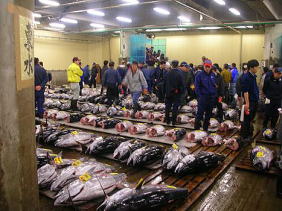 |
@The Tsukiji fish market (the central, wholesale fish market of Tokyo)
sells a great variety of local fish every morning; bonito and tuna from
the warm current and herring and codfish from the cold waters, for example.
One can find the best blow fish in winter, the best red snapper in spring,
the best bonito in early summer and mid fall, and the best sanma (Pacific
saury) in early fall, and so forth.
|
| [Photo:@Mr. Tadashi Nagai] |
|
@@Today, many popular fish in Japan such as red snapper, flounder, yellow
tail, tuna, and eel are now farm-raised to meet increasing demand and to
stabilize prices. Thanks to the highly developed farming technology, some
fishes are not necessarily inferior to the ones naturally grown in the
sea.
@Accordingly, it is now possible to find most popular fish throughout the
year at relatively reasonable prices. In fact, seafood is so critical to
the Japanese diet that, Japan now imports much more fish from all over
the world.
@A Japanese today, according to the recent Japanese fishery white paper, eats an average of about 70kg (154 pounds) of fish a year.@This is 6th largest consumption in the world, today.
@The world champion of fish consumers, according to the report of FAO (
UN Food and Agriculture Organization), however, is now Republic of The
Maldives. A Maldivian consumes about 140kg (308 pounds) of fish a year.
@The consumption of fish in Japan is reported to have been decreasing for
the past years.
The most prominent phenomenon that has caused the fact that the Japanese eat less fish and seafood than before is that the dietary life of the Japanese has been greatly westernized or internationalized. This tendency ended up that they eat more meat than before. Children or young adults prefer meat to fish. Firstly, the bones of fish, big or small, are obstacle to them.
@The meat, however prepared it may be, is much easier for them to handle
and eat. Mothers generally feel more comfortable to see their children
happy at the table than to train and teach them how to handle and eat fish.
They seem reluctant to discipline their children through the meals at the table. While it has been repeated through generations, the consumption of fish of the Japanese has ended up decreasing.
Visiting Tsukiji Market, the wholesale fish market of Metropolitan Tokyo, early in the morning is now programmed in sightseeing tours for both local and foreign visitors. It is amazing to see the bidding scene of fresh tuna at Tsukiji market. Auction of the fresh tunas starts at 5:00 am. Hundreds fresh tunas from Croatia, Turkey, India, Australia, and Ooma, the northern sea of Japan and many more places are laid down on draining boards spread on the cold concrete floor of the auction room. The tale part is deeply scored to show how fatty the flesh of the fish is. The buyers take a careful look at the scored surface and even touch it to check how fatty the tuna is but never try to eat or lick. The Auction itself is so mysterious to the outsiders like us who are not in the particular business. The auctioneer stands in front of a tuna. Some bidders stand facing to him. The auctioneer murmurs in low voice in the language we never understand. He twitters something and the buyers respond to him not with words but showing their hands, thus they communicate and the trade is finished in a second. Outsiders can never understand how the communication is done and how much the tuna is. It begins all of a sudden rather quietly and ends in some seconds. All hundreds tuna have been sold in 30 minutes.
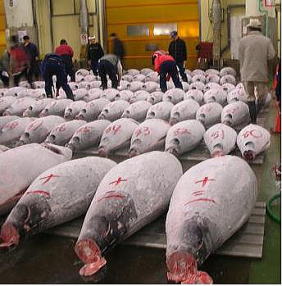 |
@Then the next room of frozen tuna market is opened and they finish the business in another 30 minutes. Surprisingly, this is repeated everyday, which means Tokyoites consume this much of tuna everyday!? Who eats it? Not me, never.
@90 percent of tuna that have been caught in many different seas in the
world are consumed in Japan. Incredible to me, but seems true and real.
Quite recently the world seemed to impose the legal controls on the tuna
import and export. It grew a big concern of the Japanese and the sushi
lovers in the world. Fortunately or unfortunately, the matter was so controversial
for a while but was rejected at CITES (Convention on International Trade
in Endangered Species of Wild Fauna And Flora) in March 2010. |
| @[Photo:@Mr. Tadashi Nagai] |
|
@Japan is the 6th biggest fish consuming country in the world today, yet
their longevity is no.1. It makes us to be sure that balanced diet is the
key to our health.
Fish Classification:
White Meat Fish and Oily Blue Skinned Fish
@When we think about fish in our daily life, we, the Japanese often think
of them in terms of roughly two groups: white meat fish and red oily fish
with blue skin. This is our practical way of classifying them, and never
scientific. As always, there are some which cannot be easily classified
into either one of them. Salmon, for example, is red, but it is not thought
to be a red oily fish of the abovementioned group.
@And, this classification is not applied to fresh water fish usually.
The Japanese usually think that white meat fish are superior to those in other groups. The price of white meat fish is therefore higher. Among all the white meat fish, red snapper or sea bream, tai in Japanese (photo #1) and left-eyed flounder, hirame in Japanese (photo # 2) are considered the best and most highly appreciated.
Tai is always served to celebrate almost all the happy occasions such as
wedding, birth of a baby, graduation, dedication of a building to name
a few.
| tai (photo #1) |
hirame (photo #2) |
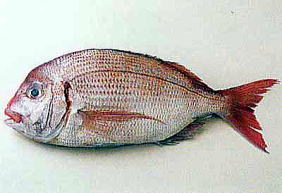 |
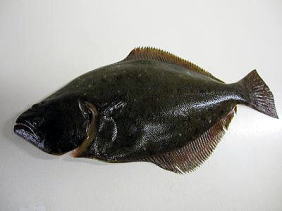 |
@On the contrary, many red oily fish with blue skin are popular fish on
our daily table. Many of them such as sardines and mackerel are available
from nearby seas almost all the time.
These fish that are caught more than we need immediately have also been
preserved for later use.
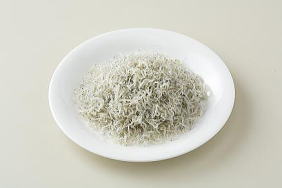 |
@Sardines, for example, are thought to be the cheapest fish. When they are young and tiny, 1.2cm (about 1/2 inch) long or so, they are cooked in seawater as they are caught, and then dried. This has been an important source of calcium and other minerals t o those who do not have the habit of drinking milk. |
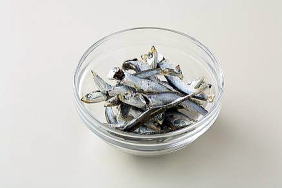 |
@When they grow to about 5 cm (2-inch) long, they are cooked and dried
to be used as an ingredient to make a fish stock. |
 |
@When they become an adult fish, they are cooked in many different ways:
sashimi when they are really fresh, salt-broiled, cooked with ginger slices
in soy sauce-based cooking sauce, fried, minced to make fish balls and
so forth. Because of EPA (Eicosapentaenoic acid) and DHA (Docosahexaenoic
acid) that have been proved to help reduce cholesterol, sardine that contains
high level of EPA and DHA is now much more appreciated than before, though.
Japanese people have strong impression of the cheapest fish on sardine
but it is the most valuable and healthful fish.
|
@Likewise, we now know that most red, oily fish with blue skin has more
EPA and DHA although we cannot eat the fish of this type every day.
Living Fish, The Freshest
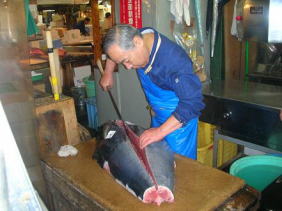 |
@Freshness is especially important in seafood because some fish get spoiled very quickly once they have left water. The Japanese especially appreciate freshness of seafood because they eat lots of uncooked seafood though not every fish.
@Archeologists think that the people of this land must have started to
eat uncooked fish thousands of years ago. They say that the fish bones
excavated from the remains of the Jomon period (4,500 BC) did not show
the trace of being exposed to fire.
@Nothing is fresher than the fish that is still alive. To satisfy those
who pursue freshness to this extent, I will mention three typical examples,
but I don't mean that the fish in my recipes should be as fresh as these
examples. |
| @[Photo:@Mr. Tadashi Nagai] |
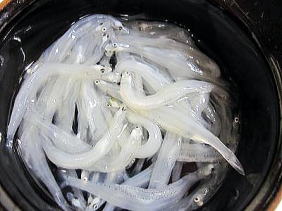 @The first example is shirauo, literally meaning white @ fish, of the salmon family. Shirauo live close
to the mouth of a river and swim into the river to lay eggs in early spring.
Shirauo at this stage are tiny fish of about a small finger size but much
thinner. They are translucent while they are alive and uncooked, but they
turn into snow white as soon as they are exposed to heat. Hence they are
called shirauo, 'white fish'. Some people in Japan like to eat shirauo
while they are still alive and swimming. They are caught as they start
to swim into the river. They are caught with a net and served in a large
bowl, still swimming in it. To eat, they are scooped into a dipping sauce,
and then carried into the mouth down the throat tickling. My husband reported
to me every time he ate shirauo in this way, but he did not sound that
he had enjoyed this way of eating them. So I have not tried yet. Where
can you try? In Fukuoka, Kyushu, for sure in the beginning of March. If
you are lucky enough to find this fish at a fishmonger, you can try at
home with a sauce with vinegar and soy sauce. @The first example is shirauo, literally meaning white @ fish, of the salmon family. Shirauo live close
to the mouth of a river and swim into the river to lay eggs in early spring.
Shirauo at this stage are tiny fish of about a small finger size but much
thinner. They are translucent while they are alive and uncooked, but they
turn into snow white as soon as they are exposed to heat. Hence they are
called shirauo, 'white fish'. Some people in Japan like to eat shirauo
while they are still alive and swimming. They are caught as they start
to swim into the river. They are caught with a net and served in a large
bowl, still swimming in it. To eat, they are scooped into a dipping sauce,
and then carried into the mouth down the throat tickling. My husband reported
to me every time he ate shirauo in this way, but he did not sound that
he had enjoyed this way of eating them. So I have not tried yet. Where
can you try? In Fukuoka, Kyushu, for sure in the beginning of March. If
you are lucky enough to find this fish at a fishmonger, you can try at
home with a sauce with vinegar and soy sauce.
 The second example is eating edancing' shrimp. (ebi no odori-gui). The second example is eating edancing' shrimp. (ebi no odori-gui).
You can try this at a sushi bar if you find shrimp in a tank. I can't guarantee its price, though. Shrimp fresh from the tank are shelled but their tails are kept with the flesh for serving. When you eat, you pick them up by the tail, dip them in soy sauce with wasabi, and eat. The shrimp are edancingf through this whole process.
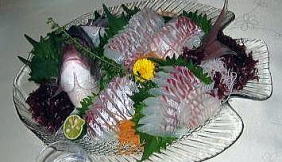 @The third example is ikezukuri, sashimi of the fillets of a fish of a foot or two feet long depending on the number of people who will be eating. When a fish is filleted, its bones are kept without damage with its head and tail on. After the fillets are sliced into sashimi size, the slices are laid on the bones of the fish. The bones are arched with a piece of thread tied from the head to the tail as if it looks like a boat. You can find ikezukuri at Japanese seafood restaurants that have a tank to keep fish alive. Many inns near the coast try to attract people with ikezukuri of a big fish. Needless to say, the slices are freshest and possibly jerk on the table. The big eyes of the fish are also watching you as you eat it. @The third example is ikezukuri, sashimi of the fillets of a fish of a foot or two feet long depending on the number of people who will be eating. When a fish is filleted, its bones are kept without damage with its head and tail on. After the fillets are sliced into sashimi size, the slices are laid on the bones of the fish. The bones are arched with a piece of thread tied from the head to the tail as if it looks like a boat. You can find ikezukuri at Japanese seafood restaurants that have a tank to keep fish alive. Many inns near the coast try to attract people with ikezukuri of a big fish. Needless to say, the slices are freshest and possibly jerk on the table. The big eyes of the fish are also watching you as you eat it.
@At home and in my recipe, I don't ask the freshness of this degree. But it will be worth reviewing how to check how fresh a fish is when you buy a fish.
Smell is the most prominent element to check the freshness of fish. What kind of smell? No smell at all. If a fish smells fishy, it is no longer fresh. At sushi bars, most of the fish served are raw, however, they do not smell fishy at all, because the fish served there are all quite fresh.
@The eyes of a fish should be clear. If they are cloudy, it is no longer
fresh.
The body should firm and shiny. The colors of it should be clear.
The gill should be bright red.If any dripping from the fish can be seen
around it, it is no longer fresh.
Fish And Special Occasions in Japan
New Yearfs Day
@There are 31 annual festivals that are celebrated nationwide in Japan.
20 out of 31 are celebrated with specially prepared food. Among them all,
New Yearfs Day is the most special day for all the Japanese to celebrate.
For this occasion, traditionally, they spend a few days to prepare a lot
of celebrating dishes with special fish and seafood and its products, vegetables,
especially root vegetables, fruits, beans, nuts and so on.
@The fish most appreciated in this occasion is Tai, red snapper, lobster
or prawns, dried sardines of a kind, salted herring roe and may be scallops.
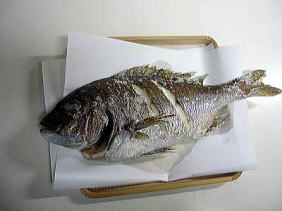 Red snapper, tai in Japanese language, is related to gmedetaih which means
ghappyh. Red snapper, tai in Japanese language, is related to gmedetaih which means
ghappyh.
And something red symbolizes happiness in this country. The whole fish is salted and just grilled. It is specially named gNirami-daih. It is not supposed to be eaten but just to look at to appreciate its beautiful appearance from hence it is called so. However it actually looks staring around to protect us from evils with authority.
Lobster or prawns are usually crooked when cooked without giving any special care or technique. People wish to live long or until their backs bend just like the ones of lobsters or prawns. Longevity used to be valued most among all of good things by the Japanese.
 A certain kind of dried sardines named gtatsukurih literally meaning gto
plow rice paddiesh is also eaten on New Yearfs. Japanese used to use this
kind of fish as fertilizer for the rice paddies. They wished to be able
to work hard in the paddies to produce as much rice, their staple food,
as possible. This was an idea when Japan was still a farming country. Tatsukuri
are roasted crispy first and then caramelized to finish up in the sauce
of sugar and soy sauce. A certain kind of dried sardines named gtatsukurih literally meaning gto
plow rice paddiesh is also eaten on New Yearfs. Japanese used to use this
kind of fish as fertilizer for the rice paddies. They wished to be able
to work hard in the paddies to produce as much rice, their staple food,
as possible. This was an idea when Japan was still a farming country. Tatsukuri
are roasted crispy first and then caramelized to finish up in the sauce
of sugar and soy sauce.
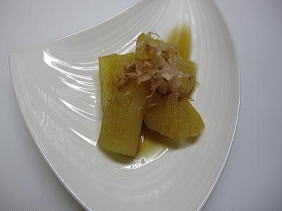 Clustered herring roe, kazunoko in Japanese, are strongly salted for preservation. People enjoy its pleasant crunchy texture wishing for the prosperity of their offspring as many as herring roe. Kazunoko is first unsalted by soaking in fresh water for a couple of days and then seasoned with soy sauce and dried fine bonito flakes. It is eaten uncooked but not fishy at all. Clustered herring roe, kazunoko in Japanese, are strongly salted for preservation. People enjoy its pleasant crunchy texture wishing for the prosperity of their offspring as many as herring roe. Kazunoko is first unsalted by soaking in fresh water for a couple of days and then seasoned with soy sauce and dried fine bonito flakes. It is eaten uncooked but not fishy at all.
 Scallops, ghotate-gaih in Japanese, literally meaning gsailing shellfishh
are thought to be one of the lucky symbols to kick off a new year. They
are in good size to be served and already steamed immediately after catching.
People just cook them in lightly sweet and salty sauce and ginger. Scallops, ghotate-gaih in Japanese, literally meaning gsailing shellfishh
are thought to be one of the lucky symbols to kick off a new year. They
are in good size to be served and already steamed immediately after catching.
People just cook them in lightly sweet and salty sauce and ginger.
Coming of Age Day
@While still people in the mood of New Yearfs, on 2nd Monday of January, Japan celebrates Coming-of-Age Day; the day to celebrate the young who become 20 years old within the year. They are welcomed to the world of grownups, which means they are given right to vote, can drink alcoholic beverages, can smoke, and can get married without permissions from their parents, and so forth.
If families have sons or daughters of this age, they celebrate it with
tai prepared in the same way as for New Yeafs or as sashimi as a whole
fish. For celebration a perfect whole fish with head and tail are valued
so much as a symbol of happiness
Childrenfs Day (traditional Boyfs Day) and Girlfs Day
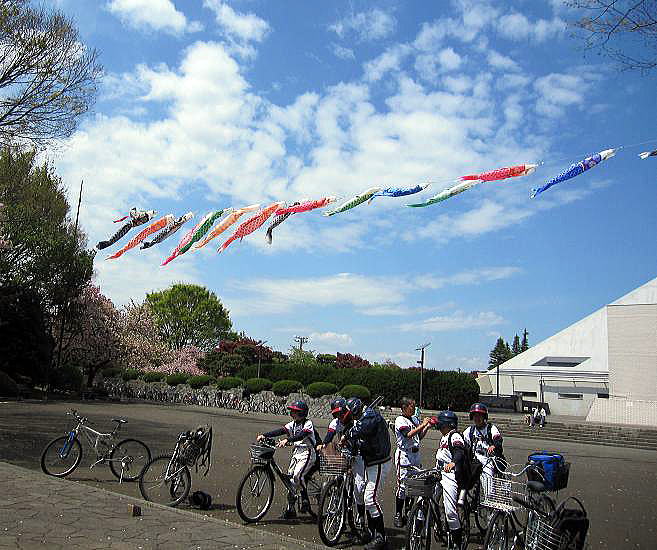
@
@May 5th, used to be Boyfs Day; the day to celebrate boyfs growth. Up until
the end of the World War II, Childrenfs growth was celebrated separately
for boys and girls from the feudalistic idea. There used to be a remonstrance,
gBoys and girls should not sit together at age of 7h. It disappeared from
this country immediately after the end of the WWII due to the adoption
of ideas of democracy from USA. Although boys and girls celebrate Childrenfs
Day equally together, May 5th has still strong tendency as Boyfs Day. On
the day or a couple of weeks prior to it,@carp banners fly over the roof
of the houses if the residents have sons in their family.
 The carp banners are synthetic and not real living fish. But inside the
houses, they celebrate this day with cooked head of red snapper. The head
of red snapper resembles a helmet of samurai worrier that symbolizes their
courage. Parents want their sons to be courageous and a head of chicken
rather than a tail of ox. The carp banners are synthetic and not real living fish. But inside the
houses, they celebrate this day with cooked head of red snapper. The head
of red snapper resembles a helmet of samurai worrier that symbolizes their
courage. Parents want their sons to be courageous and a head of chicken
rather than a tail of ox.
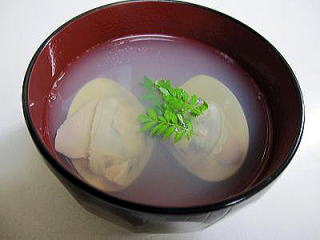 On the contrary, people celebrate Girlfs Day on March 3rd as Dollfs Festival,
wishing their daughters good health. On this day, they prepare colorful
mixed sushi and clear soup of Japanese sea clams. This soup is eaten wishing
their daughters the good health and the prosperity of their offspring. On the contrary, people celebrate Girlfs Day on March 3rd as Dollfs Festival,
wishing their daughters good health. On this day, they prepare colorful
mixed sushi and clear soup of Japanese sea clams. This soup is eaten wishing
their daughters the good health and the prosperity of their offspring.
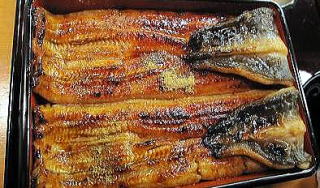 @ One day around mid July is supposed to be the hottest day in Japan. It
is dog day. Before all the houses became equipped with air conditioners,
people suffered so much from the heat and high humidity in the summer time
in Japan. It is still so hot and humid even today, which makes people down.
To regain their energy and power that they have lost from the critical
climate, people eat grilled eels. Living eels or uncooked ones are not
usually available at fishmongers. People go to special restaurants for
it or just buy already cooked ones. For most of the Japanese, eels seem
so delicious. Quite unfortunately, I cannot appreciate it. This is the
only food I cannot eat. On the Dog Day in July, wonderful smell from grilling
eels and basting them with special sauce spreads all over the street. People,
sniffing and irresistible, are attracted by the smell and led to the eel
restaurants near by. They try to survive the harsh summer with heat and
humidity in a delicious way. @ One day around mid July is supposed to be the hottest day in Japan. It
is dog day. Before all the houses became equipped with air conditioners,
people suffered so much from the heat and high humidity in the summer time
in Japan. It is still so hot and humid even today, which makes people down.
To regain their energy and power that they have lost from the critical
climate, people eat grilled eels. Living eels or uncooked ones are not
usually available at fishmongers. People go to special restaurants for
it or just buy already cooked ones. For most of the Japanese, eels seem
so delicious. Quite unfortunately, I cannot appreciate it. This is the
only food I cannot eat. On the Dog Day in July, wonderful smell from grilling
eels and basting them with special sauce spreads all over the street. People,
sniffing and irresistible, are attracted by the smell and led to the eel
restaurants near by. They try to survive the harsh summer with heat and
humidity in a delicious way.
How The Japanese Enjoy the Fish
@As sushi is now common and popular food in all the parts of the world
as one of the best-known Japanese food, it is quite natural that many people
think that Japanese people eat raw fish or sushi everyday. I feel sad that
only sushi is known to the world as Japanese food. Japan is not always
raw fish (Somebody wrote a book by this title decades ago). They cook it
in many different ways; sear, grill, broil, bake, boil, cook in sauces,
steam, fry, sauté, etc. However, they love to eat it as sashimi
first when it is really fresh.
They clearly can tell the fresh fish from the frozen and thawed one. Frozen fish is not eaten raw except for tuna, gmaguroh in Japanese, or salmon.
The fish eaten as sashimi is mostly from the sea. Basically, fish from river or fresh water is not eaten raw except just for one or two kinds in some regions because they know there is a possibility that the river fish has some parasite. Salmon, these days, are served at sushi bar since sushi got popularity outside the country and the local people started ordering. I found recently that the chef at a sushi bar is not necessarily happy to serve his customers with salmon sushi because it was not traditionally done. He suggests us to freeze the salmon flesh when we eat it as sashimi or sushi at home so that he thinks the parasite dies. Especially the river trout that is difficult to tell from salmon is thought to have bigger possibility of parasite.
There are some kinds of fish that are never eaten raw. Eel is never eaten raw although they are always alive in the fish markets. Conger eel born and brought up in the sea are served steamed and then grilled. We never eat it uncooked, either.
Whenever I eat grilled fish outside the country, I could easily tell that the fish served me has not been prepared in the same manner as it is in Japan.
It has a sort of peculiar smell that is quite unpleasant to me. It makes me regret my choice of the day.
@The most important and successful key to grilling fish is to salt the
fish lightly first and allow it to stand for a couple of hours prior to
cooking so that the salt penetrates into the flesh of the fish and then
a little juice runs out of the fish together with the peculiar smell that
the fish has. This process is always done in case it is grilled, broiled,
or sautéed. A little thing goes a long way.
@The freshest fish is needed not only for sashimi or sushi but for Tempura
(deep-fried fish and seafood and vegetables in batter) as well. The key
to the successful tempura is crispness of the fried food and its lightness.
In order to make light and crispy tempura, really fresh ingredients are
called for. Old fish and seafood contains more juice or moisture in it
than fresh ones. This moisture prevents the fried food from getting crispy
but makes it soggy. It is usually served with a little amount of grated
fresh daikon and soy sauce.
A day old fish is often cooked in sweet and salty cooking sauce. Most of the fish can be well appreciated in this way.
Marinating fish in white miso from Kyoto, slightly sweetened with liquid
candy, is another outstanding method for a day old fish. Frozen black cod,
imported from the US might be the best fish for this.
@Fish that cannot be consumed as fresh are lightly salted and dried either
naturally in the sun or dried in the room with synthetic wind immediately
after catching or fishing.
Those dried fish is usually just lightly grilled to serve for lunch. Most common fish for drying are horse mackerel, sardine, smelt, mackerel, salmon, pacific saury, light eye flounder and so on.
@People who loves Japanese saké long for the coming of the winter.
It brings them the season of blowfish, the well known poisonous fish, fugu.
Its appearance is not lovely at all but rather ugly or comical with a big
head part and skin of design like that of tiger, from hence it is named
tiger-blowfish, tora-fugu in Japanese.
@It has to be prepared by only licensed person. They know which parts of
the fish are poisonous and remove them perfectly before filleting or cutting.
The meat of the fish is rather tough when eaten raw. Therefore in order
to prepare it for sashimi, it is very thinly sliced, so thinly as the design
and color of the plate on which it is displayed can be seen through the
slices of the fish. This sashimi is served not with wasabi but grated daikon
with chili pepper, chopped green onions and vinegar-based sauce. Cut up
meat with bones are usually deep-fried. Also they make rice in soup with
the stock from the bones. It is a specialty in wintertime.
Keiko Hayashi
|